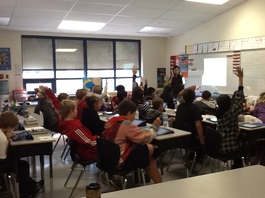"Is it possible to design lessons that sacrifice neither content nor engagement, given the time constraints?"
Mr. Hong was gracious enough to act out a brief skit with me, to introduce the importance of bibliographies:
He enthusiastically told me about the plot and characters of a book he read; but when I inquired about the title, author, date of publication, etc., he unfortunately could not remember. If only he wrote down those key details, then we could both go back to read the wonderful book again! That is one reason why we write down our sources when doing research- so we/others could go back to the same sources if necessary.
The meticulous details and punctuations in bibliographies could be cumbersome for students- unless some friendly competition is involved! Students worked in groups to write down the bibliography information for a particular website, and then each group was responsible for writing on the board one piece of bibliography information. Other groups had to keep their eyes pealed for mistakes, as both correct answers and corrections for other groups earned the group points!
Lesson Reflections:
Mr. Hong was gracious enough to act out a brief skit with me, to introduce the importance of bibliographies:
He enthusiastically told me about the plot and characters of a book he read; but when I inquired about the title, author, date of publication, etc., he unfortunately could not remember. If only he wrote down those key details, then we could both go back to read the wonderful book again! That is one reason why we write down our sources when doing research- so we/others could go back to the same sources if necessary.
The meticulous details and punctuations in bibliographies could be cumbersome for students- unless some friendly competition is involved! Students worked in groups to write down the bibliography information for a particular website, and then each group was responsible for writing on the board one piece of bibliography information. Other groups had to keep their eyes pealed for mistakes, as both correct answers and corrections for other groups earned the group points!
Lesson Reflections:
- Group activities are a lot of fun, but it took longer than anticipated (could only cover bibliographies for websites; did not get to bibliographies for images). Is it possible to design lessons that sacrifice neither content nor engagement, given the time constraints? Or does one have to try to balance both and sometimes sacrifice one for the other?
- Getting students to speak about key points they have learned in the lesson would be a good way to review and wrap up the lesson

 RSS Feed
RSS Feed